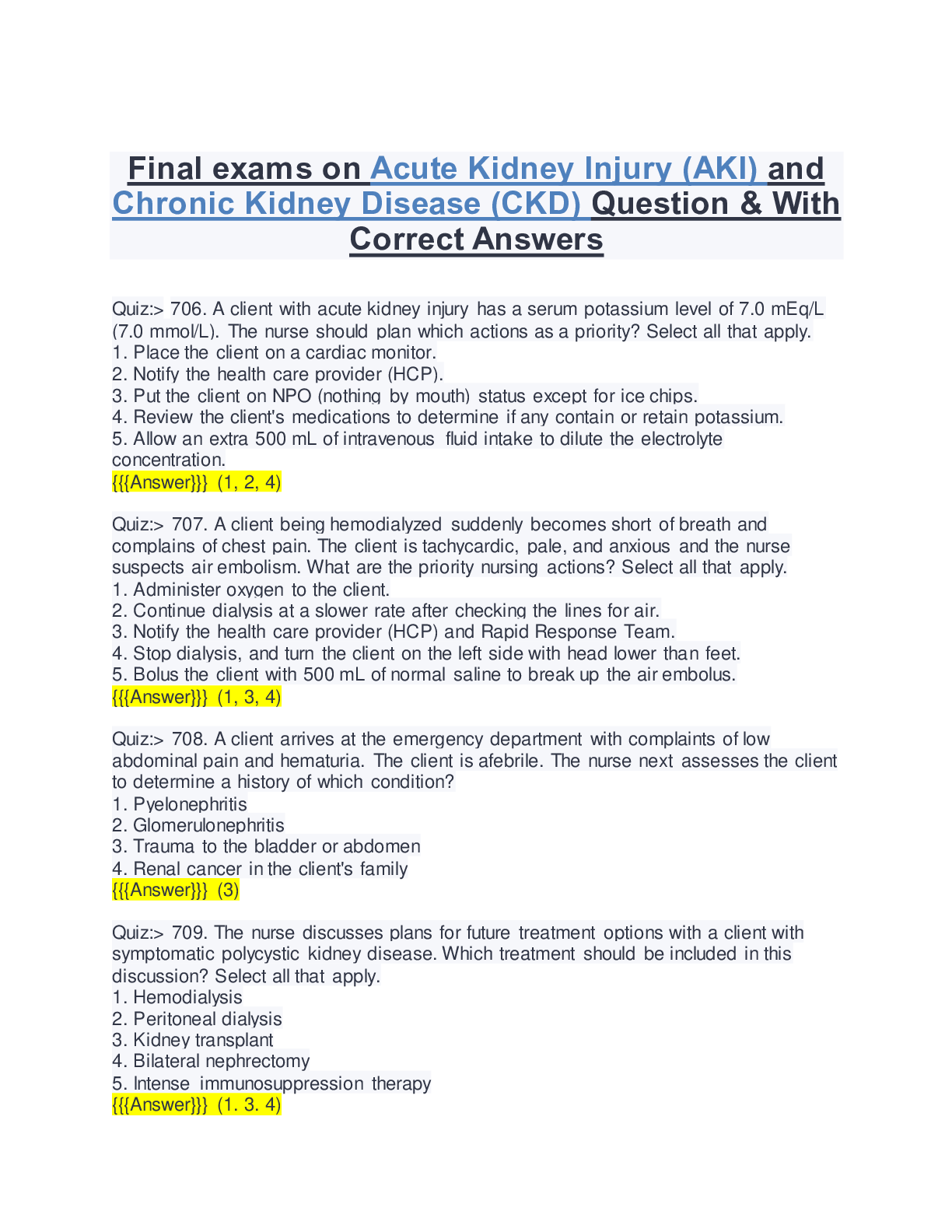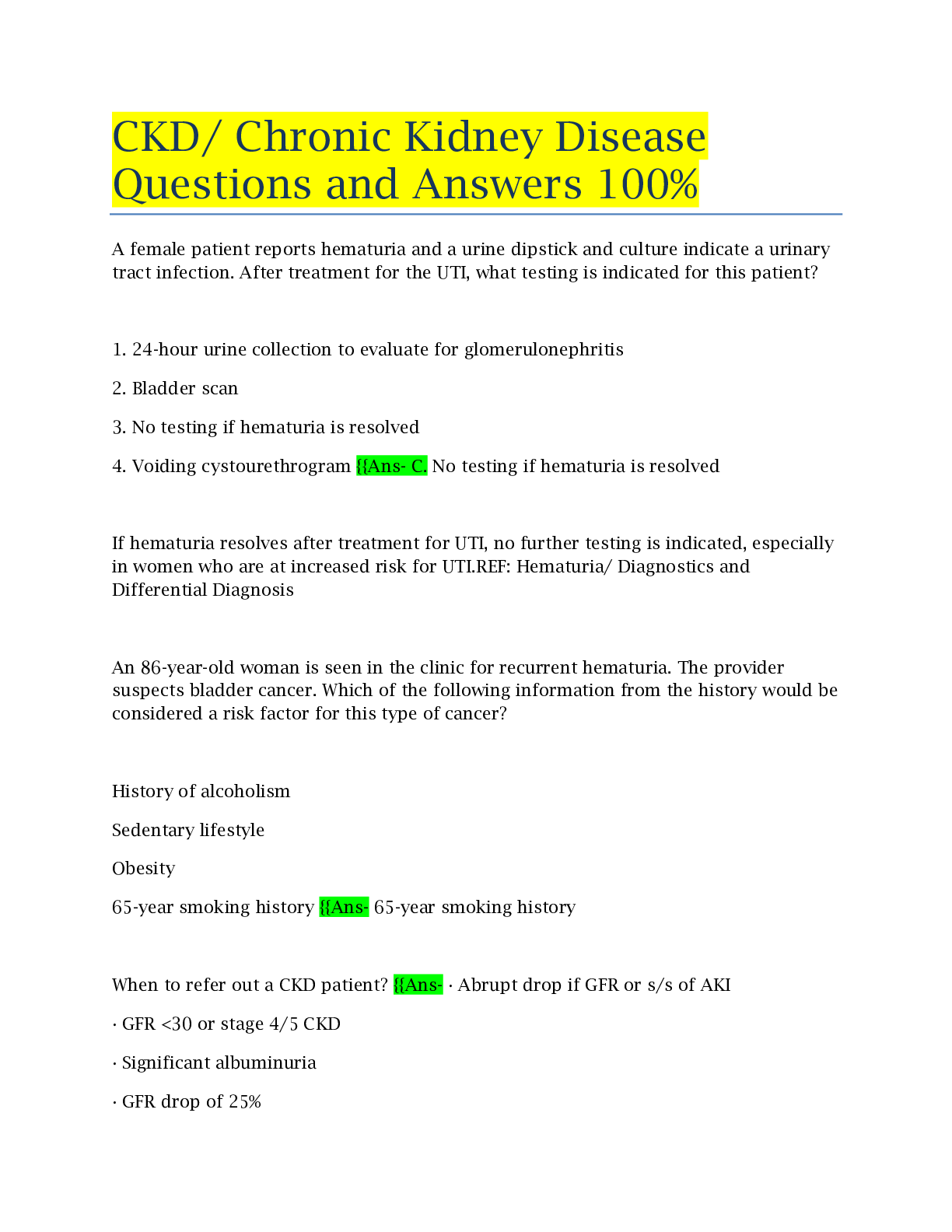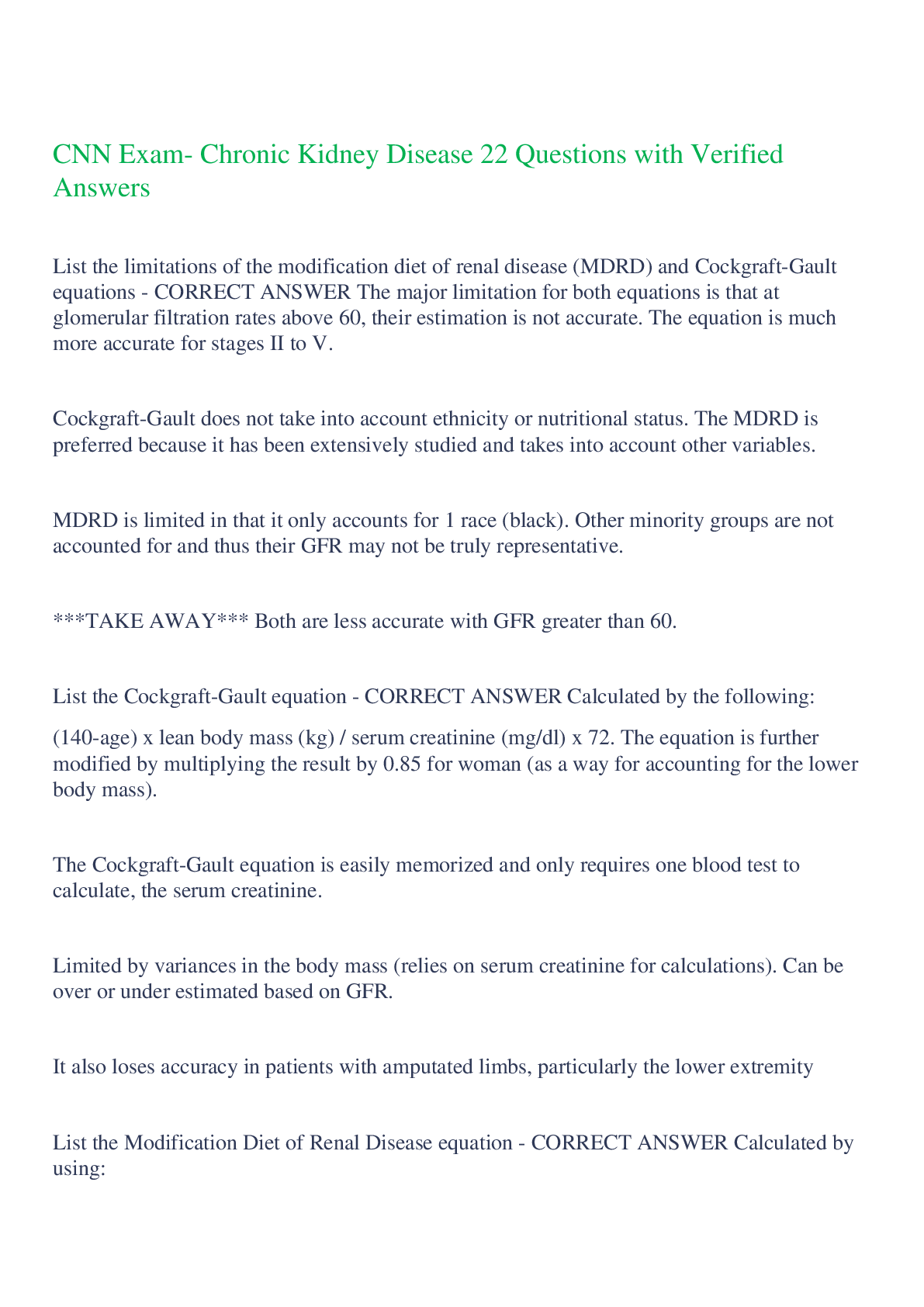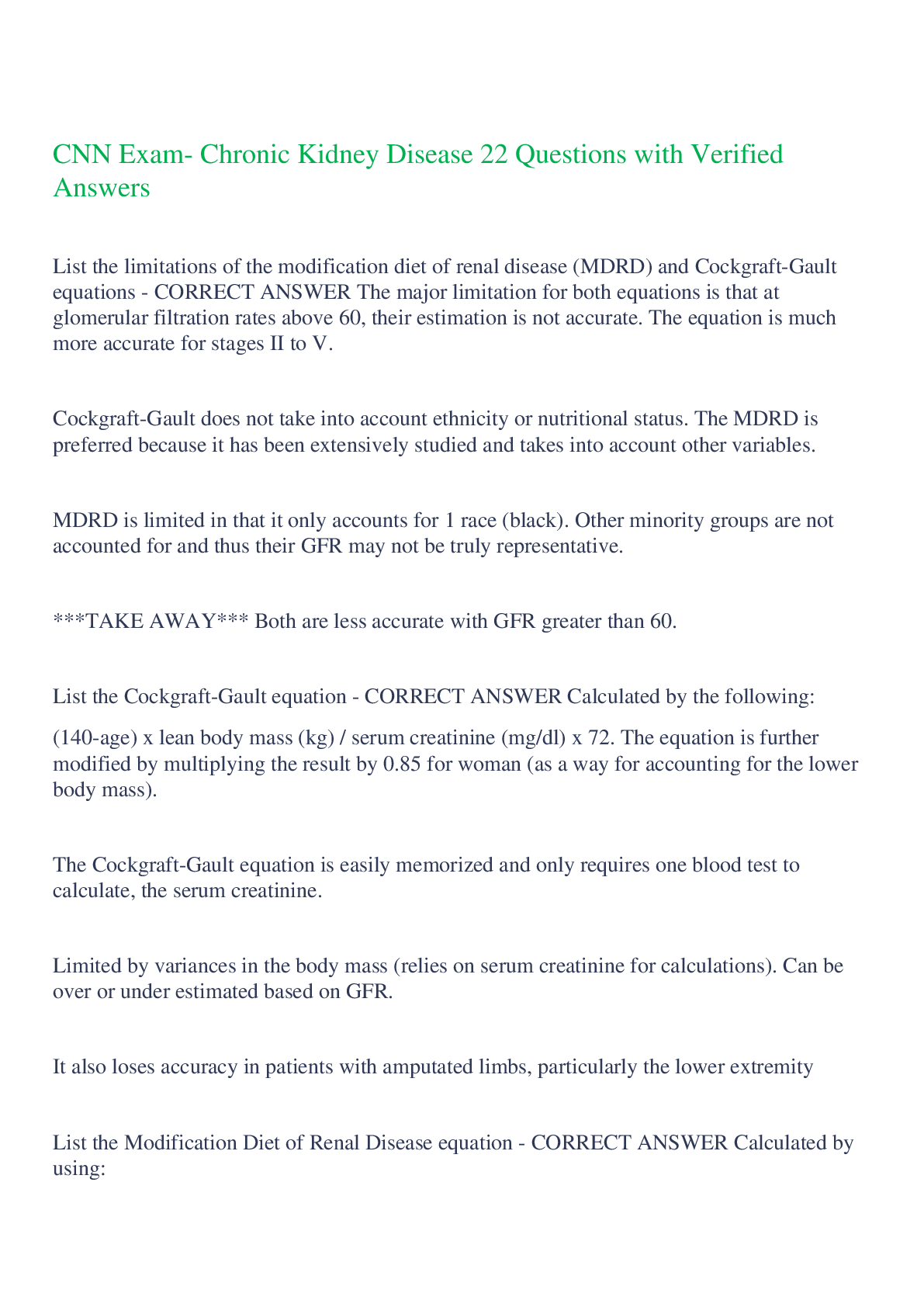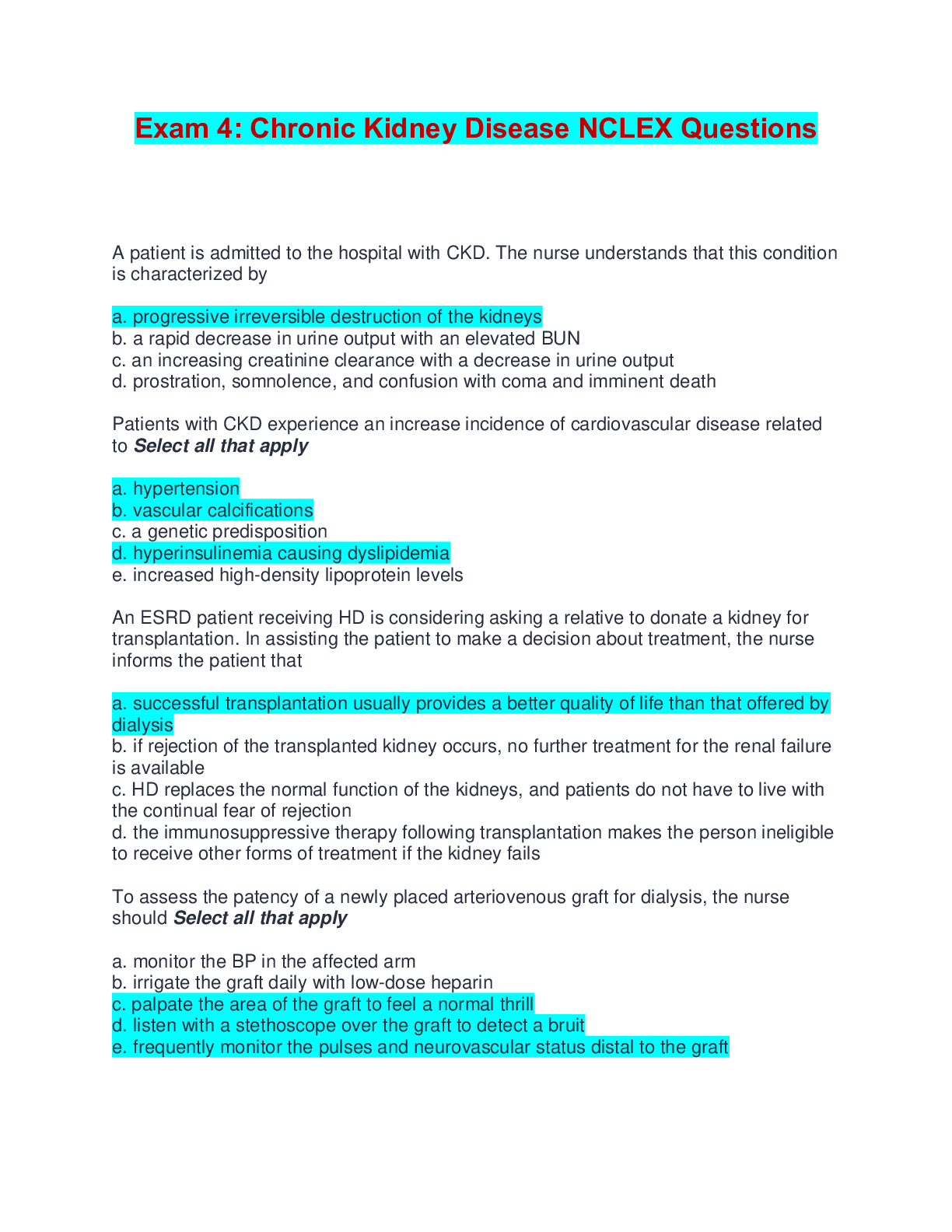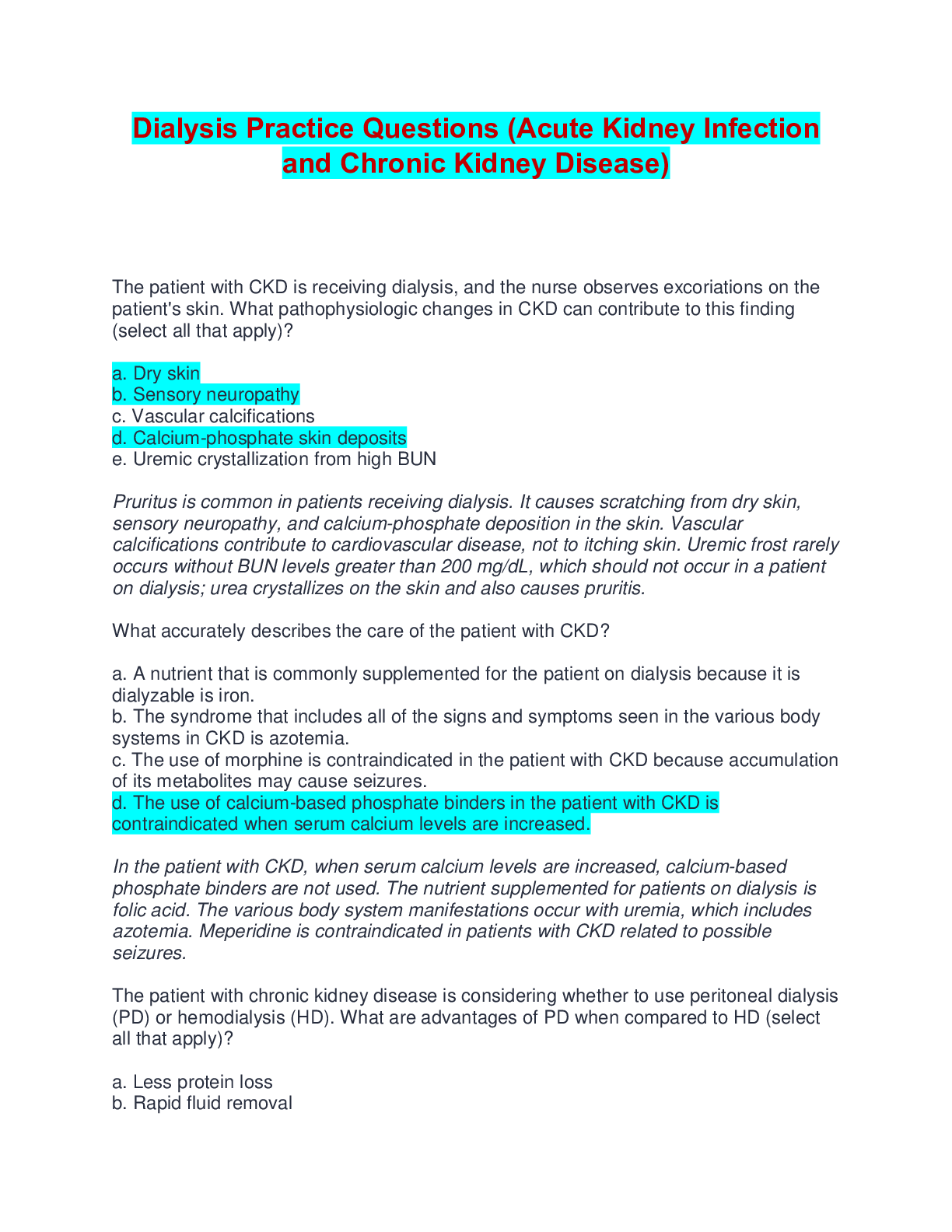Health Care > EXAM > Care of Patients with Acute Kidney Injury and Chronic Kidney Disease (All)
Care of Patients with Acute Kidney Injury and Chronic Kidney Disease
Document Content and Description Below
1. Which client is most at risk for developing postrenal kidney failure? a. Client diagnosed with renal calculi b. Client with congestive heart failure c. Client taking NSAIDs for arthritis pain d... . Client recovering from glomerulonephritis ANS: A Causes of postrenal kidney failure include disorders that obstruct the flow of urine, such as renal calculi. Heart failure can lead to prerenal failure, which is due to decreased blood flow to the kidneys. Both NSAIDs and glomerulonephritis can damage the kidney, leading to intrarenal failure. DIF: Cognitive Level: Comprehension/Understanding REF: p. 1538 TOP: Client Needs Category: Physiological Integrity (Physiological Adaptation—Pathophysiology) MSC: Integrated Process: Nursing Process (Assessment) 2. A client is admitted to the hospital with a serum creatinine level of 2 mg/dL. When taking the client’s history, which question does the nurse ask first? a. “Do you take any nonprescription medications?” b. “Does anyone in your family have kidney disease?” c. “Do you have yearly blood work done?” d. “Is your diet low in protein?” ANS: A Acute renal failure can be caused by certain medications considered to have a nephrotoxic effect, such as NSAIDs and acetaminophen. Asking the client whether he or she takes any nonprescription drugs can help determine which medication(s) might have contributed to the problem. A family history is important but is not as vital as assessing for nephrotoxic agents that the client may have ingested. Yearly blood work might reveal a trend in kidney function, but again would not be as important. A diet low in protein would not be an important factor to assess. DIF: Cognitive Level: Application/Applying or higher REF: N/A TOP: Client Needs Category: Physiological Integrity (Physiological Adaptation—Pathophysiology) MSC: Integrated Process: Nursing Process (Assessment) 3. A client with a decreased glomerular filtration rate asks how to prevent further damage to the kidneys. Which is the nurse’s best response? a. “The diuretics you are taking will prevent further damage.” b. “Kidney damage is inevitable as you age.” c. “Avoid taking NSAIDs.” d. “You will need to follow a high-protein diet.” ANS: C CARE OF PATIENTS WITH ACUTE KIDNEY INJURY AND CHRONIC KIDNEY DISEASE Kidney failure causes many problems, including decreased glomerular filtration rate. Nephrotoxins can worsen renal failure, especially in someone who already has some loss of kidney function. DIF: Cognitive Level: Comprehension/Understanding REF: p. 1539 TOP: Client Needs Category: Physiological Integrity (Reduction of Risk Potential—Potential for Complications from Surgical Procedures and Health Alterations) MSC: Integrated Process: Nursing Process (Implementation) 4. A client who has chronic kidney disease is being discharged from the hospital after receiving treatment for a hip fracture. Which information is most important for the nurse to provide to the client before discharge? a. “Increase your intake of foods with protein.” b. “Monitor your daily intake and output.” c. “Maintain bedrest until the fracture is healed.” d. “Take your aluminum hydroxide (Nephrox) with meals.” ANS: D Aluminum hydroxide lowers serum phosphate levels by binding phosphorus present in food. High blood phosphate levels cause hypocalcemia and osteodystrophy; this makes a client prone to fracture. Increasing protein may not be feasible for a client with chronic kidney disease and would not help prevent fracture. Intake and output will not be helpful for orthopedic problems. Bedrest will promote complications. DIF: Cognitive Level: Application/Applying or higher REF: N/A TOP: Client Needs Category: Physiological Integrity (Pharmacological and Parenteral Therapies— Expected Actions/Outcomes)MSC: Integrated Process: Teaching/Learning 5. Which intervention is most important for the nurse to implement in a client after kidney transplant surgery? a. Promote acceptance of new body image. b. Monitor magnesium levels daily. c. Place the client on protective isolation. d. Remove the indwelling (Foley) catheter as soon as possible. ANS: D Because of increased risk for infection related to immune suppressive drugs given to prevent rejection, the catheter is removed as soon as possible to avoid infection, usually 3 to 7 days after surgery. The client may need assistance with changes in body image, but this is not the priority. The client does not require protective precautions. Laboratory values will be monitored frequently in a post-transplant client, but this is not as important as preventing a complication by removing the catheter. DIF: Cognitive Level: Application/Applying or higher REF: N/A TOP: Client Needs Category: Physiological Integrity (Reduction of Risk Potential—Potential for Complications from Surgical Procedures and Health Alterations) MSC: Integrated Process: Nursing Process (Implementation) 6. During a hot summer day, an older adult client tells the clinic nurse, “I am not drinking or voiding that much these days.” The nurse notes a heart rate of 100 beats/min and a blood pressure of 90/60 mm Hg. Which action does the nurse take first? a. Give the client something to drink. b. Insert an intravenous catheter. c. Teach the client to drink 2 to 3 liters a day. d. Perform a bladder scan to assess urine volume. ANS: A Severe blood volume depletion can lead to kidney failure, even in those who have no kidney problem. The client is showing signs of mild volume depletion. The first action the nurse should take is to give the client something to drink. After that, the nurse should teach the client to avoid dehydration by drinking at least 2 to 3 L of fluid daily. The client does not need an IV at this time. Performing a bladder scan will not help prevent or reverse the client’s problem. DIF: Cognitive Level: Application/Applying or higher REF: N/A TOP: Client Needs Category: Physiological Integrity (Reduction of Risk Potential—Potential for Alterations in Body Systems) MSC: Integrated Process: Nursing Process (Implementation) 7. A client is taking furosemide (Lasix). To detect a common adverse effect, the nurse obtains which assessment as a priority? a. Breath sounds b. Heart sounds c. Intake and output d. Nutritional patterns ANS: C Lasix is a diuretic that causes increased urine output. If too much urine output occurs, the client may be at risk for hypovolemia, which is a cause of prerenal kidney failure. A marked change in fluid balance seen in the intake and output measurement can help identify the client who may be at risk for hypovolemia. Heart sounds and breath sounds would be more important to assess if the client was receiving Lasix for fluid overload conditions, such as heart failure. Nutrition assessment is important to ensure that the client gets enough potassium, but dehydration is more common and needs more vigorous assessment. DIF: Cognitive Level: Application/Applying or higher REF: N/A TOP: Client Needs Category: Physiological Integrity (Reduction of Risk Potential—Potential for Alterations in Body Systems) MSC: Integrated Process: Nursing Process (Assessment) 8. A client with acute kidney failure and on dialysis asks how much fluid will be permitted each day. Which is the nurse’s best response? a. “This is based on the amount of damage to your kidneys.” b. “You can drink an amount equal to your urine output, plus 700 mL.” c. “It is based on your body weight and changes daily.” d. “You can drink approximately 2 liters of fluid each day.” ANS: B For clients on dialysis, fluid intake is generally calculated to equal the amount of urine excreted plus 500 to 700 mL. DIF: Cognitive Level: Comprehension/Understanding REF: p. 1556 TOP: Client Needs Category: Physiological Integrity (Physiological Adaptation—Illness Management) MSC: Integrated Process: Teaching/Learning 9. Which statement by a client who has undergone kidney transplantation indicates a need for more teaching? a. “I will need to continue to take insulin for my diabetes.” b. “I will have to take my cyclosporine for the rest of my life.” c. “I will take the antibiotics three times daily until the medication is finished.” d. “My new kidney is working fine. I do not need to take medications any longer.” ANS: D A crucial role of the nurse in long-term follow-up of the kidney transplantation client involves maintenance of prescribed drug therapy. Such clients will need to take immune suppressants for the rest of their lives to prevent rejection of the kidney. DIF: Cognitive Level: Application/Applying or higher REF: N/A TOP: Client Needs Category: Health Promotion and Maintenance (Self-Care) MSC: Integrated Process: Teaching/Learning 10. Which staff member does the charge nurse assign to care for a client newly diagnosed with chronic kidney disease? a. Licensed practical nurse who usually works on the unit b. Registered nurse floated from the hemodialysis unit c. Registered nurse who has taken care of this client before d. Registered nurse with the most years of experience ANS: C Provide continuity of care, whenever possible, by using a consistent nurse-client relationship to decrease anxiety and promote discussion of concerns. DIF: Cognitive Level: Application/Applying or higher REF: N/A TOP: Client Needs Category: Psychosocial Integrity (Support Systems) MSC: Integrated Process: Nursing Process (Implementation) 11. A client has been missing some scheduled hemodialysis sessions. Which intervention is most important for the nurse to implement? a. Discussing with the client his or her acceptance of the disease b. Discussing with the client the option of peritoneal dialysis c. Rescheduling the sessions to another day or another time d. Stressing to the client the importance of going to the sessions ANS: A Some people on dialysis retreat into complete or partial denial of the disease and the need for treatment. They may deny the need for dialysis and/or may not adhere to drug therapy and diet restrictions. Providing support as the client struggles to accept the disease is an important step in ensuring compliance with the dialysis regimen. The nurse should explore scheduling options, but missing so many sessions cues the nurse that a bigger problem than just scheduling is involved. The nurse should provide education, but simply stressing the need for dialysis will not help the client accept it. Peritoneal dialysis, with its technical demands on the client and partner, probably is not an option for a client who appears noncompliant with hemodialysis. DIF: Cognitive Level: Application/Applying or higher REF: N/A TOP: Client Needs Category: Psychosocial Integrity (Therapeutic Communication) MSC: Integrated Process: Nursing Process (Implementation) 12. Assessment findings reveal that a client with chronic kidney disease is refusing to take prescribed medications because of the “cost.” The client also is having difficulty performing activities of daily living and prefers to sleep most of the day. To which health care team member does the nurse refer the client? a. Home health aide b. Physical therapist c. Psychiatric nurse practitioner d. Physician ANS: C Professionals from many disciplines are resources for the client with renal failure. A psychiatric evaluation may be needed if depressive symptoms are present. Refusing treatment, having difficulty performing activities of daily living, and excessive sleeping could be signs of depression. DIF: Cognitive Level: Application/Applying or higher REF: N/A TOP: Client Needs Category: Safe and Effective Care Environment (Collaboration with Interdisciplinary Team) MSC: Integrated Process: Nursing Process (Planning) 13. A client has a serum creatinine level of 2 mg/dL and a urine output of 1000 mL/day. How does the nurse categorize the client’s kidney injury? a. Intrarenal b. Nonoliguric c. Prerenal d. Postrenal ANS: B Some clients have a nonoliguric form of acute renal failure (ARF), in which urine output remains near-normal but creatinine rises. The other categories relate to the cause of acute kidney injury. DIF: Cognitive Level: Application/Applying or higher REF: N/A TOP: Client Needs Category: Physiological Integrity (Physiological Adaptation—Pathophysiology) MSC: Integrated Process: Nursing Process (Analysis) 14. A client has a serum creatinine level of 2.5 mg/dL, a serum potassium level of 6 mmol/L, an arterial pH of 7.32, and a urine output of 250 mL/day. Which phase of acute kidney failure is the client experiencing? a. Intrarenal b. Nonoliguric c. Oliguric d. Postrenal ANS: C The oliguric phase of acute kidney failure is characterized by the accumulation of nitrogenous wastes, resulting in increasing levels of serum creatinine and potassium, bicarbonate deficit, and decreased or no urine output. Intrarenal and postrenal refer to causes of kidney injury. Nonoliguric is not a classification. DIF: Cognitive Level: Application/Applying or higher REF: N/A TOP: Client Needs Category: Physiological Integrity (Physiological Adaptation—Pathophysiology) MSC: Integrated Process: Nursing Process (Analysis) 15. A client has been diagnosed with acute postrenal kidney injury. Which assessment finding does the nurse assess most carefully for? a. Blood urea nitrogen (BUN), 35 mg/dL b. Creatinine, 2.5 mg/dL c. Feeling of urgency d. Weight gain and edema ANS: C Postrenal kidney failure is identified by focusing on urinary obstructive problems. Symptoms include changes in the urine stream or difficulty starting urination. All the other distractors can be seen with prerenal and intrarenal kidney injury. DIF: Cognitive Level: Application/Applying or higher REF: N/A TOP: Client Needs Category: Physiological Integrity (Physiological Adaptation—Pathophysiology) MSC: Integrated Process: Nursing Process (Assessment) 16. A client with chronic hypertension is seen in the clinic. Which assessment indicates that the client’s hypertension is not under control? a. Heart rate of 55 beats/min b. Serum creatinine level of 1.9 mg/dL c. Blood glucose level of 128 mg/dL d. Irregular heart sounds ANS: B Increased blood pressure damages the delicate capillaries in the glomerulus and eventually results in acute kidney injury. An elevated serum creatinine level is a manifestation of this. Heart rate, blood glucose level, and irregular heart sounds are not correlated with acute kidney injury. DIF: Cognitive Level: Application/Applying or higher REF: N/A TOP: Client Needs Category: Physiological Integrity (Reduction of Risk Potential—Laboratory Values) MSC: Integrated Process: Nursing Process (Evaluation) 17. A client is scheduled to have dialysis in 30 minutes and is due for the following medications: vitamin C, B-complex vitamin, and cimetidine (Tagamet). Which action by the nurse is best? a. Give medications with a small sip of water. b. Hold all medications until after dialysis. c. Give the supplements, but hold the Tagamet. d. Give the Tagamet, but hold the supplements. ANS: B All three medications are dialyzable, meaning that they will be removed by the dialysis. They should be given after the treatment is over. DIF: Cognitive Level: Application/Applying or higher REF: N/A TOP: Client Needs Category: Physiological Integrity (Physiological Adaptation—Illness Management) MSC: Integrated Process: Nursing Process (Analysis) [Show More]
Last updated: 2 years ago
Preview 1 out of 17 pages

Buy this document to get the full access instantly
Instant Download Access after purchase
Buy NowInstant download
We Accept:

Reviews( 0 )
$13.50
Can't find what you want? Try our AI powered Search
Document information
Connected school, study & course
About the document
Uploaded On
Aug 27, 2022
Number of pages
17
Written in
Additional information
This document has been written for:
Uploaded
Aug 27, 2022
Downloads
0
Views
44












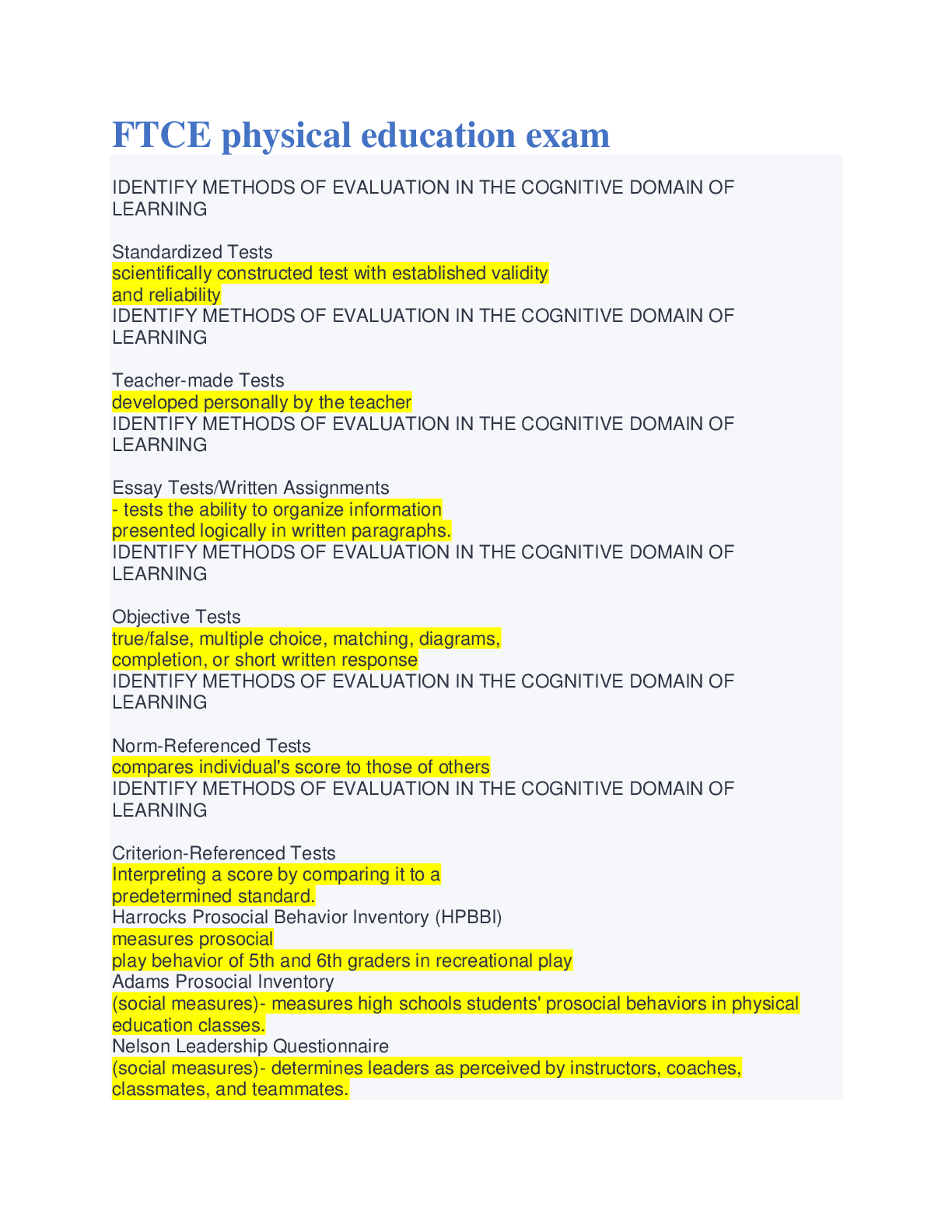

.png)

